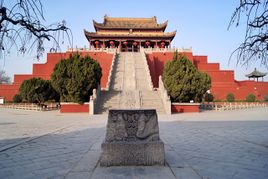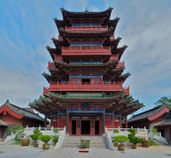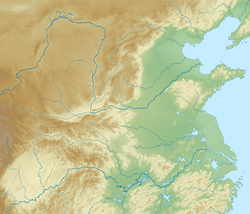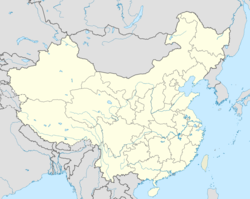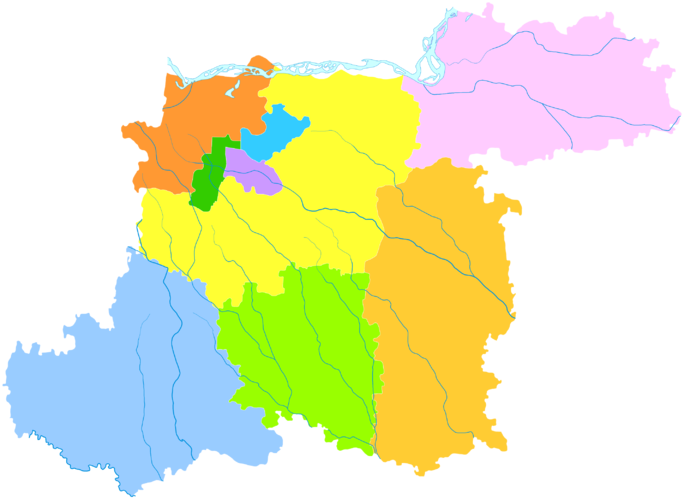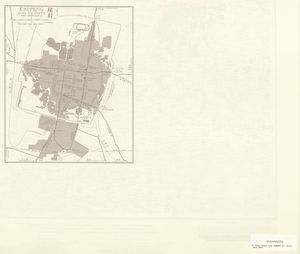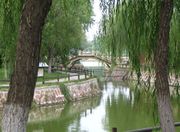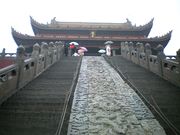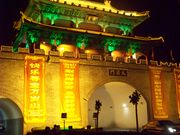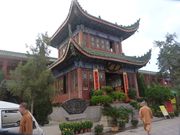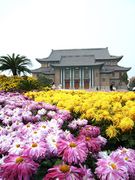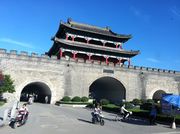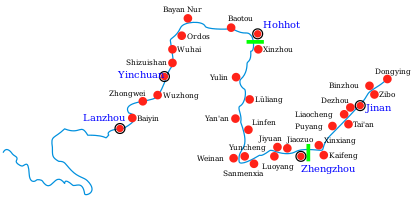كايفنگ
كايفنگ
开封市 Kaifeng | |
|---|---|
مع عقارب الساعة: Dragon Pavilion, Iron Pagoda, Lu Zhishen Daxiangguo Temple, Songdu Royal Street, Kaifeng Mayor's Mansion | |
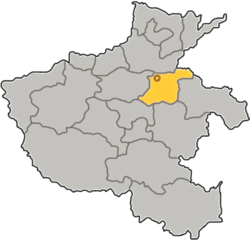 موقع زمام مدينة كايفنگ في هنان | |
الموقع في North China Plain | |
| الإحداثيات (Kaifeng municipal government): 34°47′53″N 114°18′51″E / 34.7981°N 114.3143°ECoordinates: 34°47′53″N 114°18′51″E / 34.7981°N 114.3143°E | |
| البلد | جمهورية الصين الشعبية |
| المقاطعة | Henan |
| Municipal seat | Longting District |
| المساحة | |
| • مدينة بمستوى محافظة | 6٬247 كم² (2٬412 ميل²) |
| • الحضر | 546٫4 كم² (211�0 ميل²) |
| • العمران | 546٫4 كم² (211�0 ميل²) |
| المنسوب | 75 m (245 ft) |
| التعداد (2010 census) | |
| • مدينة بمستوى محافظة | 4٬676٬159 |
| • الكثافة | 750/km2 (1٬900/sq mi) |
| • Urban | 826٬961 |
| • الكثافة الحضرية | 1٬500/km2 (3٬900/sq mi) |
| • العمرانية | 826٬961 |
| • الكثافة العمرانية | 1٬500/km2 (3٬900/sq mi) |
| منطقة التوقيت | UTC+8 (China Standard) |
| مفتاح الهاتف | 371 |
| ISO 3166 code | CN-HA-02 |
| GDP | ¥7,250 per capita (2004) |
| Major Nationalities | Han, Hui |
| County-level divisions | 5 |
| License plate prefixes | 豫B |
| الموقع الإلكتروني | kaifeng |
| كايفنگ | |||||||||||||||||||||||||
|---|---|---|---|---|---|---|---|---|---|---|---|---|---|---|---|---|---|---|---|---|---|---|---|---|---|
 "كايفنگ" بالحروف الصينية المبسطة (أعلى) والتقليدية (أسفل) | |||||||||||||||||||||||||
| الصينية المبسطة | 开封 | ||||||||||||||||||||||||
| الصينية التقليدية | 開封 | ||||||||||||||||||||||||
| المعنى الحرفي | "Opening the Border" | ||||||||||||||||||||||||
| |||||||||||||||||||||||||
كايفنگ (صينية: 开封�؛ Kaifeng) هي prefecture-level city in east-central Henan province, China. It is one of the Eight Ancient Capitals of China, having been the capital seven times in history, and is best known for being العاصمة الصينية في أسرة سونگ الشمالية.
Around 5 million people currently live in Kaifeng's metropolitan area. Located along the Yellow River's southern bank, it borders the provincial capital of Zhengzhou to the west, Xinxiang to the northwest, Shangqiu to the east, Zhoukou to the southeast, Xuchang to the southwest, and Heze of Shandong to the northeast.
. . . . . . . . . . . . . . . . . . . . . . . . . . . . . . . . . . . . . . . . . . . . . . . . . . . . . . . . . . . . . . . . . . . . . . . . . . . . . . . . . . . . . . . . . . . . . . . . . . . . . . . . . . . . . . . . . . . . . . . . . . . . . . . . . . . . . . . . . . . . . . . . . . . . . . . . . . . . . . . . . . . . . . . .
الأسماء
The postal romanization for the city is "Kaifeng". Its official one-character abbreviation in Chinese is 汴 (Biàn). Historically it has also been known as
The area was named "Kaifeng" after the Qin's conquest of China in the second century BC. The name literally means "opening the border" and figuratively "hidden" and "vengeance".[1] Its name was originally Qifeng (صينية: 啓封�), but the syllable qi (Baxter-Sagart: /*kʰˤijʔ/) was changed to the essentially synonymous kai (/*Nə-[k]ʰˤəj/, /*[k]ʰˤəj/) to avoid the naming taboo of Liu Qi (Emperor Jing of Han).
الادارة
The prefecture-level city of Kaifeng administers five districts and four counties:
- Gulou District (鼓楼区)
- Longting District (龙亭区)
- Yuwangtai District (禹王台区)
- Xiangfu District (祥符区)
- Shunhe Hui District (顺河回族区)
- Weishi County (尉氏县)
- Qi County (杞县)
- Tongxu County (通许县)
- Lankao County (兰考县)
| Map |
|---|
التاريخ
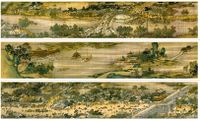
Kaifeng is one of the Eight Ancient Capitals of China. As with Beijing, there have been many reconstructions during its history.
In 364 BC during the Warring States period, the State of Wei founded a city called Daliang (大梁) as its capital in this area. During this period, the first of many canals in the area was constructed linking a local river to the Yellow River. When the State of Qin conquered the State of Wei, Kaifeng was destroyed and abandoned except for a mid-sized market town, which remained in place.
During the Han Dynasty, the city underwent some reconstruction. Kaifeng became the capital of Liu Wu (son of Han emperor Wen) when he was given the title of Liang Xiao Wang. Liu Wu restored and constructed many buildings and old city walls. Kaifeng became a center of music, art, a refuge for artists, and of splendid gardens despite the trivial political importance of the city at this period.[2]
Early in the 7th century, Kaifeng was transformed into a major commercial hub when it was connected to the Grand Canal as well as through the construction of a canal running to western Shandong.
In 781 during the Tang dynasty, a new city was reconstructed and named Bian (汴). Bian was the capital of the Later Jin (936–946), Later Han (947–950), and Later Zhou (951–960) of the Five Dynasties and Ten Kingdoms period. The Song dynasty made Bian its capital when it overthrew the Later Zhou in 960. Shortly afterwards, the city underwent further expansion.
During the Song, when it was known as Dongjing or Bianjing, Kaifeng, then the largest and most prosperous city in China, was the capital, with a population of over 400,000 living both inside and outside the city wall. Typhus was an acute problem in the city. The historian Jacques Gernet provides a lively picture of life in this period in his Daily Life in China on the Eve of the Mongol Invasion, 1250-1276, which often draws on Dongjing Meng Hua Lu, a nostalgic memoir of the city of Kaifeng.[3]
In 1049, the Youguosi Pagoda (佑國寺塔) – or Iron Pagoda as it is called today – was constructed measuring 54.7 meters (179 ft) in height. It has survived the vicissitudes of war and floods to become the oldest landmark in this ancient city. Another Song-dynasty pagoda, Po Tower, dating from 974, has been partially destroyed.
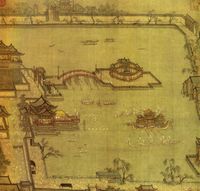
Another well-known sight was the astronomical clock tower of the engineer, scientist, and statesman Su Song (1020–1101 AD). It was crowned with a rotating armillary sphere that was hydraulically-powered (i.e. by water wheel and a water clock), yet it incorporated an escapement mechanism two hundred years before they were found in the clockworks of Europe and featured the first known endless power-transmitting chain drive.
Kaifeng reached its peak importance in the 11th century as a commercial and industrial center at the intersection of four major canals. During this time, the city was surrounded by three rings of city walls and probably had a population of between 600,000 and 700,000. It is believed that Kaifeng was the largest city in the world from 1013 to 1127.[4]
This period ended in 1127 when the city fell to Jurchen invaders during the Jingkang Incident. It subsequently came under the rule of the Jurchen Jin dynasty, which had conquered most of North China during the Jin–Song Wars.[5] While it remained an important administrative center, only the area inside the inner city wall of the early Song remained settled and the two outer rings were abandoned.
As the imperial capital of the Song, Kaifeng was conveniently situated along the Grand Canal for logistics supply but militarily vulnerable due to its position on the floodplains of the Yellow River.
Kaifeng served as the Jurchen "southern capital" from 1157 (other sources say 1161) and was reconstructed during this time.[6] The Jurchen kept their main capital further north until 1214 when they were forced to move the imperial court southwards to Kaifeng in order to flee from the onslaught of the Mongols. In 1232 they succumbed to the combined Mongol and Song forces in the Mongol siege of Kaifeng. The Mongols captured the city and in 1279 conquered all of China. During the Yuan dynasty Bianliang became the capital of Henan Jiangbei Province, which was established in 1277.
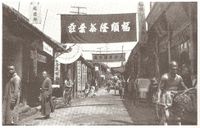
The city was briefly captured around the mid-fourteenth century by the Red Turban rebels who made it their capital for ten years. They were crushed by the early Ming forces. At the beginning of the Ming dynasty in 1368, Kaifeng was made the capital of Henan province.[2]
In 1642, Kaifeng was flooded by the Ming army with water from the Yellow River to prevent the peasant rebel Li Zicheng from taking over. After this disaster, the city was abandoned again.
In 1662, during the reign of the Kangxi Emperor in the Qing dynasty, Kaifeng was rebuilt. Another reconstruction in 1843 followed flooding in 1841, shaping Kaifeng as it stands today.
On 6 June 1938, the city was occupied by the invading Japanese Imperial Army.
Kaifeng is also known for having the oldest extant Jewish community in China, the يهود كايفنگ.
Kaifeng remained the capital of Henan province until 1954, when it was moved to Zhengzhou.
في 1969، توفي رئيس جمهورية الصين الشعبية السابق، ليو شاوچي، من إهمال طبي أثناء وجوده قيد الحبس المنزلي في كايفنگ.
المناخ
Kaifeng has a monsoon-influenced humid subtropical climate (Köppen Cwa) that borders on a humid continental climate, with four distinct seasons. Winters are cool and mostly dry while summers are hot and humid; spring is warm and sees some, but not much rainfall, while autumn weather is crisp and drier. Precipitation mainly occurs from June to September.
| بيانات مناخ كايفنگ (1971–2000) | |||||||||||||
|---|---|---|---|---|---|---|---|---|---|---|---|---|---|
| الشهر | يناير | فبراير | مارس | أبريل | مايو | يونيو | يوليو | أغسطس | سبتمبر | اكتوبر | نوفمبر | ديسمبر | العام |
| العظمى القياسية °س (°ف) | 19.2 (66.6) |
25.5 (77.9) |
29.4 (84.9) |
35.4 (95.7) |
38.1 (100.6) |
42.5 (108.5) |
39.0 (102.2) |
37.6 (99.7) |
35.6 (96.1) |
34.1 (93.4) |
26.6 (79.9) |
22.2 (72) |
42٫5 (108٫5) |
| العظمى المتوسطة °س (°ف) | 5.1 (41.2) |
8.4 (47.1) |
13.7 (56.7) |
21.5 (70.7) |
26.9 (80.4) |
31.3 (88.3) |
31.7 (89.1) |
30.5 (86.9) |
26.7 (80.1) |
21.3 (70.3) |
13.7 (56.7) |
7.3 (45.1) |
19٫84 (67٫72) |
| المتوسط اليومي °س (°ف) | 0.0 (32) |
2.7 (36.9) |
7.9 (46.2) |
15.3 (59.5) |
20.7 (69.3) |
25.3 (77.5) |
26.9 (80.4) |
25.9 (78.6) |
21.1 (70) |
15.1 (59.2) |
7.8 (46) |
1.9 (35.4) |
14٫22 (57٫59) |
| الصغرى المتوسطة °س (°ف) | −4.1 (24.6) |
−1.7 (28.9) |
2.9 (37.2) |
9.6 (49.3) |
14.8 (58.6) |
19.8 (67.6) |
22.9 (73.2) |
22.0 (71.6) |
16.5 (61.7) |
10.1 (50.2) |
3.1 (37.6) |
−2.3 (27.9) |
9٫47 (49٫04) |
| الصغرى القياسية °س (°ف) | −15.0 (5) |
−14.2 (6.4) |
−7.3 (18.9) |
−1.6 (29.1) |
5.0 (41) |
11.3 (52.3) |
15.2 (59.4) |
13.5 (56.3) |
6.0 (42.8) |
−0.2 (31.6) |
−11.7 (10.9) |
-16.0 (3.2) |
−16 (3) |
| هطول mm (inches) | 8.1 (0.319) |
11.2 (0.441) |
28.2 (1.11) |
35.4 (1.394) |
55.0 (2.165) |
73.4 (2.89) |
174.9 (6.886) |
109.7 (4.319) |
69.5 (2.736) |
41.5 (1.634) |
20.4 (0.803) |
9.9 (0.39) |
637٫2 (25٫087) |
| Avg. precipitation days (≥ 0.1 mm) | 2.9 | 3.9 | 5.9 | 6.2 | 6.8 | 7.8 | 11.3 | 9.0 | 7.6 | 6.6 | 4.5 | 3.0 | 75٫5 |
| Source: Weather China | |||||||||||||
. . . . . . . . . . . . . . . . . . . . . . . . . . . . . . . . . . . . . . . . . . . . . . . . . . . . . . . . . . . . . . . . . . . . . . . . . . . . . . . . . . . . . . . . . . . . . . . . . . . . . . . . . . . . . . . . . . . . . . . . . . . . . . . . . . . . . . . . . . . . . . . . . . . . . . . . . . . . . . . . . . . . . . . .
النقل
الجوي
Downtown Kaifeng is about 55 km (34 mi) away from Zhengzhou Xinzheng International Airport (IATA: CGO, ICAO: ZHCC), which is the busiest airport in central China in terms of both passenger and cargo traffic (2017 statistics).[7]
With the completion of Zhengzhou–Kaifeng intercity railway and Zhengzhou–Xinzheng Airport intercity railway, fast train connections to Zhengzhou Xinzheng International Airport from Kaifeng became available. As of August 2018, there are 12 pairs of intercity trains running between Xinzheng Airport and Songchenglu every day, with a travel time of 53 min.
السكك الحديدية
Kaifeng railway station is on the east–west Longhai Railway mainline and provides convenient access to many cities around China, including Beijing West, Shanghai, Shanghai Hongqiao, Tianjin, Xi'an, Jinan, Hangzhou. Services to Zhengzhou, Luoyang and Qingdao are also frequent and convenient. Direct long-distance services to Shenzhen, Guangzhou, Chengdu, Chongqing North, Harbin, Ürümqi, Fuzhou, Dalian and Wuhan are also available.
The Zhengzhou–Kaifeng intercity railway (郑开城际铁路) started operation on 28 December 2014,[8] connecting the provincial capital Zhengzhou and Kaifeng. The railway currently terminates at Songchenglu, and is planned to be extended to Kaifeng railway station. The designed top speed is 200 km/h (120 mph).
Kaifeng North railway station of the Xuzhou–Lanzhou high-speed railway is the main high-speed railway station of the city. It started operation on 10 September 2016.[9]
الحافلات
There are 4 main coach stations in Kaifeng:
- Kaifeng West Coach Station (开封客运西站)
- Kaifeng Long-Distance Coach Station (开封长途汽车站)
- Kaifeng Jinming Coach Station (开封金明汽车站)
- Kaifeng Xiangguosi Coach Station (开封相国寺汽车站)
There are frequent services to many neighboring counties, other provincial cities and long-distance services to other provinces.
النقل بالطرق
 G30 Lianyungang–Khorgas Expressway
G30 Lianyungang–Khorgas Expressway G45 Daqing–Guangzhou Expressway
G45 Daqing–Guangzhou Expressway S82 Zhengzhou–Minquan Expressway
S82 Zhengzhou–Minquan Expressway S83 Lankao–Nanyang Expressway
S83 Lankao–Nanyang Expressway China National Highway 106
China National Highway 106 China National Highway 220
China National Highway 220 China National Highway 310
China National Highway 310
الثقافة
الدين

Kaifeng is known for having the oldest extant Jewish community in China, the Kaifeng Jews.
It also has a significant Muslim enclave and is notable for its many women's mosques (nǚsì), including the oldest nǚsì in China: Wangjia Hutong Women's Mosque, which dates to 1820.[10]
There are also some active Christian churches, like Sacred-Heart of Kaifeng cathedral (开封耶稣圣心主教座堂).
Cuisine
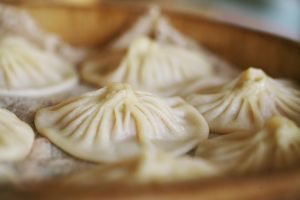
Kaifeng cuisine plays a dominant part in forming Henan cuisine.[11]
Kaifeng offers a wide range of food specialties such as steamed pie and dumplings. Particularly famous is Kaifeng's five-spice bread (wǔxiāng shāobǐng), which, like pita, can be opened and filled. In the evening, Kaifeng's streets turn into restaurants while hundreds open their stands and begin selling their food in the famous night market. People from nearby Zhengzhou often come to Kaifeng to visit family members and to enjoy the atmosphere.
The Ma Yu Ching's Bucket Chicken House (马豫兴桶子鸡;؛ Mǎ Yùxīng Tǒngzi Jī�), located in Kaifeng, is by some accounts the world's oldest restaurant.
. . . . . . . . . . . . . . . . . . . . . . . . . . . . . . . . . . . . . . . . . . . . . . . . . . . . . . . . . . . . . . . . . . . . . . . . . . . . . . . . . . . . . . . . . . . . . . . . . . . . . . . . . . . . . . . . . . . . . . . . . . . . . . . . . . . . . . . . . . . . . . . . . . . . . . . . . . . . . . . . . . . . . . . .
Chrysanthemums
The chrysanthemum is the city flower of Kaifeng. The tradition of cultivating varieties of chrysanthemums extends back 1600 years, and the scale of cultivation reached its height during the Song dynasty until its loss to the Jürchens in 1126.
The city has held the Kaifeng Chrysanthemum Cultural Festival since 1983 (renamed China Kaifeng Chrysanthemum Cultural Festival in 1994). The festival has since taken place between 18 October and 18 November of every year.
The festival reached another milestone in 2012, when it celebrated its 30th birthday.[12] The opening ceremony was broadcast live on Henan Satellite TV Channel (HNTV) at the evening prime slot on 18 October 2012, which has a coverage of all Chinese cities of or above the prefecture-level classification in the Chinese administrative division.
During the festival, hundreds of chrysanthemums breeds are on show at festival venues, and the flower becomes a common features around the city. Kaifeng has been dubbed the "city of chrysanthemums".
Sporting events
Zheng-Kai International Marathon
The China Zheng-Kai International Marathon (中国郑开国际马拉松赛, Zheng-Kai stands for "Zhengzhou-Kaifeng", also abbreviated "ZK") is a sporting event hosted jointly by the Chinese Athletic Association, the general sport administration of Henan province, Zhengzhou municipal government, and the Kaifeng municipal government. It is the premier international sports competition in Henan province and one of the biggest sports competitions in the Central-West of China. ZK International Marathon is held at the end of March or beginning of April each year. The main part of the event occurs along the famous Zhengkai Express Way (郑开大道). At its launch in 2007, 5600 athletes competed. By 2012, almost 25000 athletes from 28 countries and regions have participated in the ZK International Marathon.
Military
Kaifeng is the headquarter of the 20th Group Army of the People's Liberation Army, one of three group armies that comprise the Jinan Military Region responsible for the defense of the Yellow River Plain.
Kaifeng Air Base is a military airfield in the southern suburb of Kaifeng City. It does not provide civilian aviation service.
معرض صور
The Iron Pagoda
Entrance to the Dragon Pavilion
Daxiangguo Temple's drum tower
البلدات التوأم – المدن الشقيقة
 كريات موتسكين، إسرائيل
كريات موتسكين، إسرائيل أومسك، روسيا
أومسك، روسيا تودا، اليابان
تودا، اليابان وتشيتا، الولايات المتحدة
وتشيتا، الولايات المتحدة Wingecarribee، أستراليا
Wingecarribee، أستراليا Yeongcheon، كوريا الجنوبية
Yeongcheon، كوريا الجنوبية
الكليات والجامعات
العامة
- Henan University (河南大学) (تأسست 1912)
- جامعة كايفنگ (开封大学) (تأسست 1980)
- معهد كايفنگ للتعليم (开封教育学院)
- Yellow River Conservancy Technical Institute (黄河水利职业技术学院) (تأسست 1929)
انظر أيضاً
الهامش
- ^ 中国古今地名大辞典 (in الصينية المبسطة). Shanghai: Shanghai Lexicographical Publishing House. 2005. p. 348.
- ^ أ ب Schellinger, Paul; Salkin, Robert, eds. (1996). International Dictionary of Historic Places, Volume 5: Asia and Oceania. Chicago: Fitzroy Dearborn Publishers. p. 420. ISBN 1-884964-04-4.
- ^ Jacques Gernet. Daily Life in China on the Eve of the Mongol Invasion, 1250-1276. (Stanford, CA: Stanford University Press, 1962). Translated by H. M. Wright. ISBN 0804707200.
- ^ "Largest Cities Through History". Retrieved November 6, 2010.
- ^ Lorge, Peter (2005). War, Politics and Society in Early Modern China, 900–1795. Routledge. pp. 52–54. ISBN 978-0-203-96929-8.
- ^ "The Eastern Manchurian Woodsmen Replacing the Western Manchurian Nomads" (PDF). Retrieved November 6, 2010.
- ^ "Archived copy" 2017年民航机场生产统计公报 (in الصينية). Civil Aviation Administration of China. 2018-03-07. Archived from the original on 2015-08-23. Retrieved 2018-03-15.
{{cite web}}: CS1 maint: archived copy as title (link) - ^ 郑州开封城铁开通:省委书记玩自拍 “包拯”捧场. new.qq.com (in الصينية). Retrieved 2018-04-13.
- ^ 郑徐高铁开封北站即将开门迎宾(组图). henan.people.com.cn (in الصينية). 2016-09-07. Retrieved 2018-08-02.
- ^ NPR
- ^ "Archived copy" 豫菜成大器 任重而道远. Archived from the original on January 29, 2014. Retrieved October 28, 2012.
{{cite web}}: CS1 maint: archived copy as title (link) - ^ "China Kaifeng Chrysanthemum Cultural Festival". Retrieved October 28, 2012.
- ^ "友好都市". ekaifeng.gov.cn (in الصينية). Kaifeng. Retrieved 2020-07-14.
للاستزادة
- Cotterell, Arthur. (2007). The Imperial Capitals of China: An Inside View of the Celestial Empire. London: Pimlico. pp. 304 pages. ISBN 978-1-84595-009-5.
- The Origin of the Kaifeng Jews, in S. Shaked, ed., Irano-Judaica, Jerusalem, 1982, pp. 101–11
وصلات خارجية
- Government website of Kaifeng (in Simplified Chinese)
- Kaifeng City Portal (in Simplified Chinese)
- Notes on the Jewish colony at Kaifeng from the Papers of Charles Daniel Tenney
| سبقه Chang'an |
عاصمة الصين (بإسم كايفنگ) 960−1127 |
تبعه Lin'an |
- CS1 uses الصينية-language script (zh)
- CS1 الصينية المبسطة-language sources (zh-hans)
- CS1 الصينية-language sources (zh)
- Articles with hatnote templates targeting a nonexistent page
- Short description is different from Wikidata
- Pages using multiple image with auto scaled images
- Coordinates on Wikidata
- Articles containing صينية-language text
- مقالات تحتوي نصوصاً باللغة الصينية المبسطة
- مقالات تحتوي نصوصاً باللغة الصينية
- مقالات تحتوي نصوصاً باللغة الصينية التقليدية
- كايفنگ
- تأسيسات عقد 360 ق.م.
- 364 ق.م.
- جاليات يهودية تاريخية
- أماكن مأهولة تأسست في القرن الرابع ق.م.

